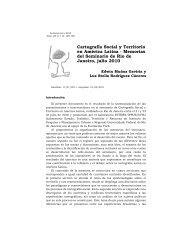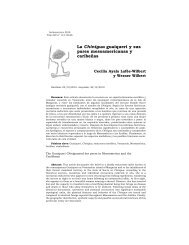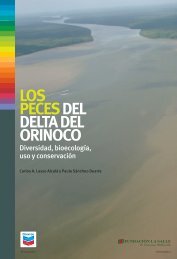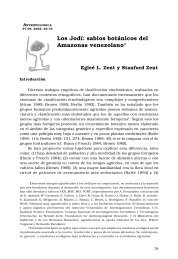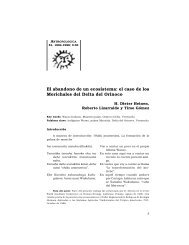War and a Semblance of Peace in the Inca Heartland
War and a Semblance of Peace in the Inca Heartland
War and a Semblance of Peace in the Inca Heartland
Create successful ePaper yourself
Turn your PDF publications into a flip-book with our unique Google optimized e-Paper software.
Inheritance <strong>of</strong> <strong>the</strong> qualities associated with be<strong>in</strong>g c<strong>in</strong>checona was<br />
expected, but <strong>the</strong>se had, none<strong>the</strong>less, to be demonstrated.<br />
Lucana was head <strong>of</strong> <strong>the</strong> Cañar mitimaes. Precisely for <strong>the</strong> Cañar region,<br />
<strong>the</strong>re is evidence for hereditary rulers. In <strong>the</strong> Historia Indica, <strong>the</strong> leader <strong>of</strong> <strong>the</strong><br />
Cañares was identified as Cañar Capac, or “<strong>the</strong> capac <strong>of</strong> <strong>the</strong> Cañares”<br />
(Sarmiento de Gamboa 1906, chp. 44: 87). Sarmiento’s sources were <strong>Inca</strong>s, so<br />
here we are deal<strong>in</strong>g with <strong>Inca</strong> underst<strong>and</strong><strong>in</strong>gs. The <strong>Inca</strong>s <strong>the</strong>mselves were<br />
capac, that is, <strong>the</strong>y recognized a hereditary status that passed through <strong>the</strong><br />
descendants <strong>of</strong> Manco Capac <strong>and</strong> a sister, who had emerged from <strong>the</strong> central<br />
w<strong>in</strong>dow at Tambotoco, eleven generations before <strong>the</strong> Spaniards arrived. Capac<br />
status was not someth<strong>in</strong>g <strong>the</strong> <strong>Inca</strong>s had known <strong>the</strong>y possessed all along: it<br />
was revealed to <strong>the</strong>m <strong>in</strong> several episodes by a solar deity connected with<br />
warfare (Julien 2000a: 23-42). The <strong>Inca</strong>s Sarmiento <strong>in</strong>terviewed described <strong>the</strong><br />
leaders <strong>of</strong> a number <strong>of</strong> powerful prehispanic groups as capac. They were<br />
obstacles to <strong>the</strong> <strong>Inca</strong> expansion, <strong>and</strong> <strong>the</strong> Cañar Capac was one <strong>of</strong> <strong>the</strong>m. Diego<br />
Lucana’s testimony, despite <strong>the</strong> use <strong>of</strong> <strong>the</strong> term c<strong>in</strong>checona, accords well with<br />
what <strong>Inca</strong> sources said about <strong>the</strong> Cañar region. What he tells us, however, is<br />
not that c<strong>in</strong>checona status was <strong>in</strong>herited, but that <strong>the</strong>re was an expectation<br />
that <strong>the</strong> qualities associated with it would transfer to <strong>the</strong> next generation.<br />
These qualities still had to be demonstrated. This also appears to have been<br />
<strong>the</strong> case with capac status.<br />
The contrast between Diego Lucana’s testimony <strong>and</strong> that given by <strong>the</strong><br />
Hur<strong>in</strong>guanca witnesses may reflect significant differences <strong>in</strong> local organization.<br />
Toledo’s Informaciones were not <strong>the</strong> first place where <strong>the</strong> term behetría had<br />
been used to describe <strong>the</strong> political organization <strong>of</strong> <strong>the</strong> Jauja valley before <strong>the</strong><br />
time <strong>of</strong> <strong>the</strong> <strong>Inca</strong> empire. Pedro de Cieza de León, who traveled through <strong>the</strong><br />
valley <strong>in</strong> 1548, described <strong>the</strong> division <strong>of</strong> <strong>the</strong> valley <strong>in</strong>to three parcialidades<br />
(subdivisions) by <strong>the</strong> <strong>Inca</strong>s, but noted that <strong>the</strong> region had been characterized<br />
by behetría before that. Cieza noted that <strong>the</strong> people <strong>of</strong> <strong>the</strong> Jauja valley were all<br />
Guancas <strong>and</strong> had a common orig<strong>in</strong> myth: <strong>the</strong>y descended from ancestors who<br />
emerged from a spr<strong>in</strong>g called Guaribilca. Perhaps he used <strong>the</strong> term behetría to<br />
characterize <strong>the</strong> political organization <strong>of</strong> <strong>the</strong> valley because <strong>the</strong> Guancas had<br />
not been united under one lord (1984, chp. 84: 242-43). When we consider<br />
<strong>the</strong> testimony <strong>of</strong> <strong>the</strong> Hur<strong>in</strong>guanca witnesses, only one said anyth<strong>in</strong>g about <strong>the</strong><br />
effective size <strong>of</strong> political units. Alonso Pomaguala testified that “each<br />
parcialidad had a c<strong>in</strong>checona, <strong>and</strong> that <strong>in</strong> this valley <strong>of</strong> Jauja, up to <strong>the</strong> moiety<br />
<strong>of</strong> <strong>the</strong> Ananguancas, <strong>the</strong> c<strong>in</strong>checonas took care <strong>of</strong> <strong>the</strong>m” (f. 17v). He seems to<br />
be <strong>in</strong>dicat<strong>in</strong>g that, although <strong>the</strong>re were divisions <strong>in</strong> <strong>the</strong> valley, <strong>the</strong> political<br />
units were not necessarily small. He may also be tell<strong>in</strong>g us that <strong>the</strong>re had<br />
been an effective boundary between <strong>the</strong> territory that later became<br />
Hur<strong>in</strong>guanca <strong>and</strong> Ananguanca. Alonso Camo, also from Hur<strong>in</strong>guanca,<br />
confirms this impression: <strong>the</strong> towns near each o<strong>the</strong>r got along well; <strong>the</strong><br />
conflict was with towns that were “not so close”. These more distant people<br />
would attack <strong>the</strong>m to take <strong>the</strong>ir l<strong>and</strong>s <strong>and</strong> <strong>the</strong>ir women (ff. 37-37v).<br />
193



